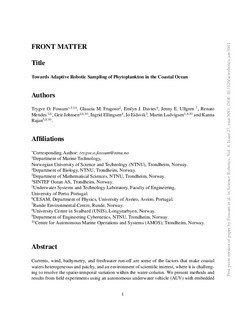Toward adaptive robotic sampling of phytoplankton in the coastal ocean
Fossum, Trygve Olav; Fragoso, Glaucia Moreira; Davies, Emlyn John; Ullgren, Jenny; Mendes, Renato; Johnsen, Geir; Ellingsen, Ingrid H.; Eidsvik, Jo; Ludvigsen, Martin; Rajan, Kanna
Journal article, Peer reviewed
Accepted version

Åpne
Permanent lenke
http://hdl.handle.net/11250/2609737Utgivelsesdato
2019Metadata
Vis full innførselSamlinger
- Institutt for biologi [2611]
- Institutt for marin teknikk [3469]
- Institutt for matematiske fag [2532]
- Institutt for teknisk kybernetikk [3784]
- Publikasjoner fra CRIStin - NTNU [38523]
Originalversjon
10.1126/scirobotics.aav3041Sammendrag
Currents, wind, bathymetry, and freshwater runoff are some of the factors that make coastal waters heterogeneous, patchy, and scientifically interesting—where it is challenging to resolve the spatiotemporal variation within the water column. We present methods and results from field experiments using an autonomous underwater vehicle (AUV) with embedded algorithms that focus sampling on features in three dimensions. This was achieved by combining Gaussian process (GP) modeling with onboard robotic autonomy, allowing volumetric measurements to be made at fine scales. Special focus was given to the patchiness of phytoplankton biomass, measured as chlorophyll a (Chla), an important factor for understanding biogeochemical processes, such as primary productivity, in the coastal ocean. During multiple field tests in Runde, Norway, the method was successfully used to identify, map, and track the subsurface chlorophyll a maxima (SCM). Results show that the algorithm was able to estimate the SCM volumetrically, enabling the AUV to track the maximum concentration depth within the volume. These data were subsequently verified and supplemented with remote sensing, time series from a buoy and ship-based measurements from a fast repetition rate fluorometer (FRRf), particle imaging systems, as well as discrete water samples, covering both the large and small scales of the microbial community shaped by coastal dynamics. By bringing together diverse methods from statistics, autonomous control, imaging, and oceanography, the work offers an interdisciplinary perspective in robotic observation of our changing oceans.